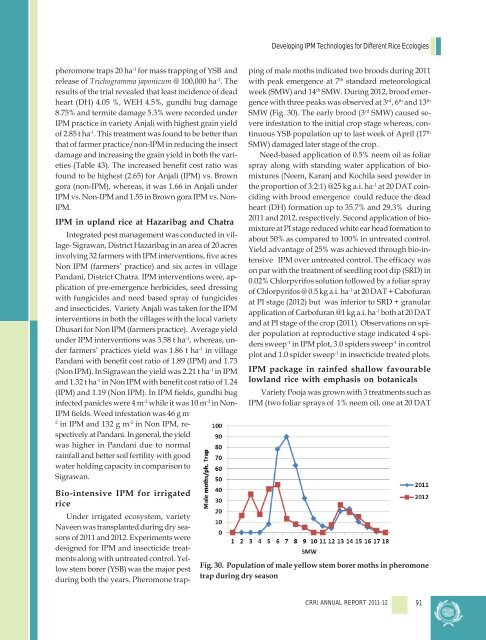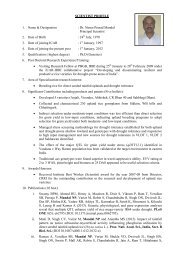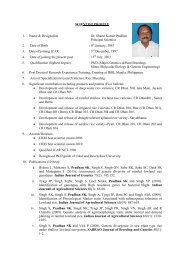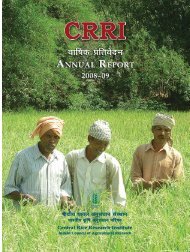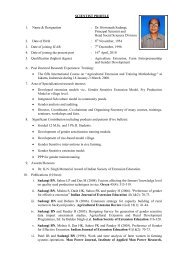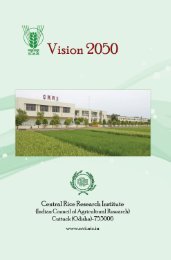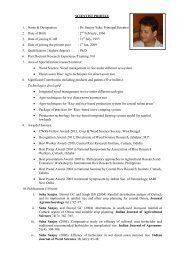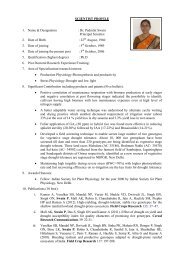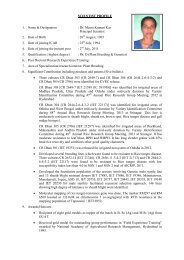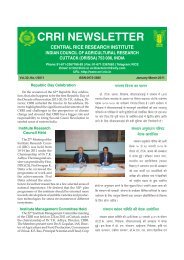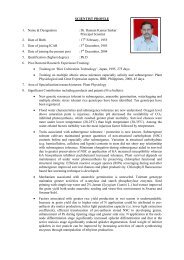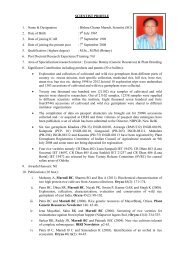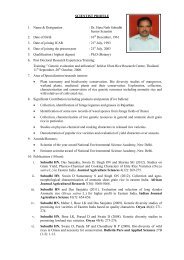Central Rice Research Institute Annual report...2011-12
Central Rice Research Institute Annual report...2011-12
Central Rice Research Institute Annual report...2011-12
You also want an ePaper? Increase the reach of your titles
YUMPU automatically turns print PDFs into web optimized ePapers that Google loves.
Developing IPM Technologies for Different <strong>Rice</strong> Ecologies<br />
pheromone traps 20 ha -1 for mass trapping of YSB and<br />
release of Trichogramma japonicum @ 100,000 ha -1 . The<br />
results of the trial revealed that least incidence of dead<br />
heart (DH) 4.05 %, WEH 4.5%, gundhi bug damage<br />
8.75% and termite damage 5.3% were recorded under<br />
IPM practice in variety Anjali with highest grain yield<br />
of 2.85 t ha -1 . This treatment was found to be better than<br />
that of farmer practice/non-IPM in reducing the insect<br />
damage and increasing the grain yield in both the varieties<br />
(Table 43). The increased benefit cost ratio was<br />
found to be highest (2.65) for Anjali (IPM) vs. Brown<br />
gora (non-IPM), whereas, it was 1.66 in Anjali under<br />
IPM vs. Non-IPM and 1.55 in Brown gora IPM vs. Non-<br />
IPM.<br />
IPM in upland rice at Hazaribag and Chatra<br />
Integrated pest management was conducted in village-<br />
Sigrawan, District Hazaribag in an area of 20 acres<br />
involving 32 farmers with IPM interventions, five acres<br />
Non IPM (farmers’ practice) and six acres in village<br />
Pandani, District Chatra. IPM interventions were, application<br />
of pre-emergence herbicides, seed dressing<br />
with fungicides and need based spray of fungicides<br />
and insecticides. Variety Anjali was taken for the IPM<br />
interventions in both the villages with the local variety<br />
Dhusari for Non IPM (farmers practice). Average yield<br />
under IPM interventions was 3.58 t ha -1 , whereas, under<br />
farmers’ practices yield was 1.86 t ha -1 in village<br />
Pandani with benefit cost ratio of 1.89 (IPM) and 1.73<br />
(Non IPM). In Sigrawan the yield was 2.21 t ha -1 in IPM<br />
and 1.32 t ha -1 in Non IPM with benefit cost ratio of 1.24<br />
(IPM) and 1.19 (Non IPM). In IPM fields, gundhi bug<br />
infected panicles were 4 m -2 while it was 10 m -2 in Non-<br />
IPM fields. Weed infestation was 46 g m -<br />
2<br />
in IPM and 132 g m -2 in Non IPM, respectively<br />
at Pandani. In general, the yield<br />
was higher in Pandani due to normal<br />
rainfall and better soil fertility with good<br />
water holding capacity in comparison to<br />
Sigrawan.<br />
Bio-intensive IPM for irrigated<br />
rice<br />
Under irrigated ecosystem, variety<br />
Naveen was transplanted during dry seasons<br />
of 2011 and 20<strong>12</strong>. Experiments were<br />
designed for IPM and insecticide treatments<br />
along with untreated control. Yellow<br />
stem borer (YSB) was the major pest<br />
during both the years. Pheromone trapping<br />
of male moths indicated two broods during 2011<br />
with peak emergence at 7 th standard meteorological<br />
week (SMW) and 14 th SMW. During 20<strong>12</strong>, brood emergence<br />
with three peaks was observed at 3 rd , 6 th and 13 th<br />
SMW (Fig. 30). The early brood (3 rd SMW) caused severe<br />
infestation to the initial crop stage whereas, continuous<br />
YSB population up to last week of April (17 th<br />
SMW) damaged later stage of the crop.<br />
Need-based application of 0.5% neem oil as foliar<br />
spray along with standing water application of biomixtures<br />
(Neem, Karanj and Kochila seed powder in<br />
the proportion of 3:2:1) @25 kg a.i. ha -1 at 20 DAT coinciding<br />
with brood emergence could reduce the dead<br />
heart (DH) formation up to 35.7% and 29.3% during<br />
2011 and 20<strong>12</strong>, respectively. Second application of biomixture<br />
at PI stage reduced white ear head formation to<br />
about 50% as compared to 100% in untreated control.<br />
Yield advantage of 25% was achieved through bio-intensive<br />
IPM over untreated control. The efficacy was<br />
on par with the treatment of seedling root dip (SRD) in<br />
0.02% Chlorpyrifos solution followed by a foliar spray<br />
of Chlorpyrifos @ 0.5 kg a.i. ha -1 at 20 DAT + Cabofuran<br />
at PI stage (20<strong>12</strong>) but was inferior to SRD + granular<br />
application of Carbofuran @1 kg a.i. ha -1 both at 20 DAT<br />
and at PI stage of the crop (2011). Observations on spider<br />
population at reproductive stage indicated 4 spiders<br />
sweep -1 in IPM plot, 3.0 spiders sweep -1 in control<br />
plot and 1.0 spider sweep -1 in insecticide treated plots.<br />
IPM package in rainfed shallow favourable<br />
lowland rice with emphasis on botanicals<br />
Variety Pooja was grown with 3 treatments such as<br />
IPM (two foliar sprays of 1% neem oil, one at 20 DAT<br />
Fig. 30. Population of male yellow stem borer moths in pheromone<br />
trap during dry season<br />
CRRI ANNUAL REPORT 2011-<strong>12</strong><br />
91


